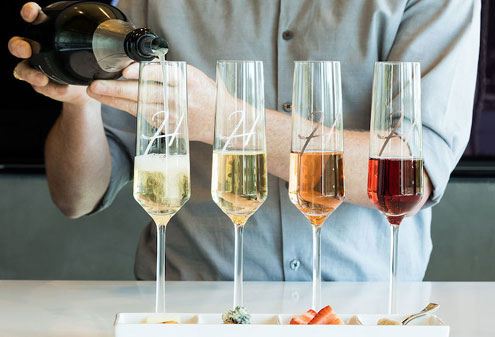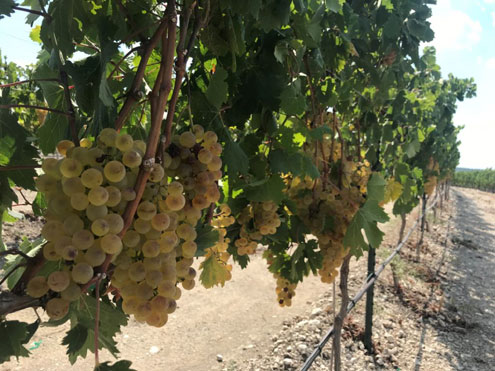Get to know varieties,
how Texas’ sparkling wine market continues to grow
The holidays are a time for celebrating, and Texas A&M AgriLife Extension Service experts say Texas sparkling wines are a buoyant option for toasting during gatherings or ringing in the New Year with friends and family.
Champagne vs. sparkling wine
All champagne is sparkling wine but not all sparkling wine is champagne.
Sparkling wine can only be called champagne if it comes from the Champagne region of France, located outside of Paris, and is made using chardonnay, pinot noir or pinot meunier grape varieties, explained Jim Kamas, AgriLife Extension fruit specialist based in Fredericksburg.
As the juice from crushed grapes ferments to become wine, carbon dioxide gas is formed as a byproduct of fermentation. If the gas is allowed to escape, the result will be a “still” or non-sparkling wine. But if at some point the fermentation process is halted and carbon dioxide gas is prevented from escaping, sparkling wine is produced.
“In more recent years, winemakers in Texas have expanded into making sparkling wines,” Kamas said. “While the traditional grape varieties used in the production of champagne are the chardonnay and pinot noir, neither of those varieties are very widely planted in Texas.”

Sparkling wines come in both white and rosé styles with a wide array of flavors and aromas depending on the grapes used and winemaking practices employed, said Michael Cook, AgriLife Extension viticulturist, Denton. Grapes commonly being used to produce sparkling wines in Texas include roussanne, Marsanne, chenin blanc, viognier, chardonnay, pinot noir, trebbiano tuscano, blanc du bois and other locally grown varieties.
“That being said, all sparkling wines share at least two things in common: sharp acidity, which helps lend to the wine’s crisp and fresh taste, and bubbles, which give a creamy and rich perception to the palate,” he said. “Because of these characteristics, sparkling wines are well suited to the typical heavy dishes served at Christmas and New Year’s. Sparkling wines are not just for celebration but pair nicely with chicken, turkey, ham, lobster, stuffing, yams, mashed potatoes, holiday pies, and don’t forget the cheese and chocolate.”
Pétillant naturel
While the rosé craze has taken the state and nation by storm, Cook said a new trend is quickly gaining popularity in the sparkling wine world – the production of pétillant naturel, or pet nat, wines. This sparkling winemaking style utilizes natural yeast and in-bottle fermentation to produce a bubble-rich wine with a wide range of light and refreshing aromas.
Cook said wineries love them because they can be offered to consumers sooner than wines that require aging, and consumers love them because they are light and refreshing.
Pet nat wines are partially fermented in vats or tanks, then transferred to bottles and sealed. The fermentation process continues in bottle, generating carbon dioxide, which creates both the pressure and the bubbles “we know and love,” said Andreea Botezatu, Ph.D, AgriLife Extension enologist, College Station.
Because these wines are not filtered or polished in any way, they tend to be cloudy and contain sediments, which is perfectly normal for this particular style of wine, Botezatu noted.
“They’re light and fruity and easy to drink,” she said. “They’re perfect for parties.”
Méthode champenoise
In July 2018, Grape Creek Vineyards opened Heath Sparkling Wines, a facility that produces four different sparkling wines bottled under the names Euphoria, Adoration, Ebullience and Blanc de Blancs. The modern-style facility, touted as “the first winery in Texas dedicated to the art of sparkling winemaking,” also has a tasting area.
“We use pinot noir and chardonnay grapes, but also produce a sparkling rosé wine using pinot grigio and a sparkling white that’s a blend of trebbiano and chenin blanc,” said Jason Englert, a winemaker for Grape Creek Vineyards in Fredericksburg.
Englert said the most well-known way of processing champagne and sparkling wines is the méthode champenoise, but the equipment for this process is specialized and very expensive, representing a substantial investment for a winery.
“So, what we do at Heath Sparkling Wines is process the grapes and ferment the juice to make the base wine (cuveé). The finished base wines are then filtered and transported by tanker to a sparkling wine processing facility in California to complete the méthode champenoise process.”
Once the process is completed, which usually takes about 18 months, the sparkling wine, which is in champagne bottles, is corked and has a wire hood applied. Then foils and labels are affixed and the bottles are placed in case boxes and palletized for return shipping.
Those proponents of the méthode champenoise point to the individual attention given each bottle and the time taken to complete the process as necessary for bringing out the full flavor and richness of the wine.
Englert noted other Texas winemakers have experimented with making sparkling wines using other methods such as the old-school pétillant naturel process and the Charmat method, a more economical production process in which still wine goes through secondary fermentation in large vessels.
Texas winemakers
Along with Heath, other Texas wineries that produce sparkling wines include Messina Hof Winery, McPherson Vineyards, Wedding Oak Winery, William Chris Vineyards, Saint Tryhpon, Spicewood Vineyards, Farmhouse Vineyards, Knipp Cellars, Southold Farm and Cellars, Landon Winery, Fiesta Winery and Whistling Duck Vineyards and Winery.

Bonarrigo said as infrastructure and knowledge bases grow there will be an expansion in the production of sparkling wines throughout the state, and consumers will see more and more wineries launching a sparkling wine product.
Cook agrees.
“Texas is really getting a foothold in the sparkling wine niche market,” he said. “Winemakers see the advantages of turning out amazingly fresh and aromatic wines that utilize grapes that may not be suited for their traditional table wines and can be offered to consumers sooner rather than later.”